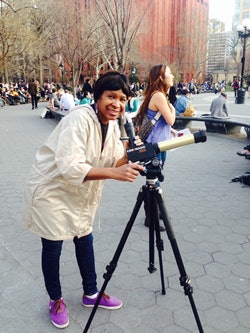 Dr. Gerceida Jones of New York University is a mentor for students eager to learn and experience science.
Dr. Gerceida Jones of New York University is a mentor for students eager to learn and experience science.An early fascination with stars in the sky kept Dr. Gerceida Jones focused even in hostile learning environments and has driven her to develop innovative ways to engage her students and foster appreciation for science.
When Jones, a master teacher in the Liberal Studies Program at New York University, was an undergraduate at the University of Michigan, she went to see her chemical oceanography professor during his office hours. Jones says he was coming up the hall, saw her, turned around and went the other way. She waited patiently at his office, but he never returned.
It was one of many unpleasant encounters she recounts of her undergraduate days, including, Jones says, one professor telling her, “You don’t belong here.” She says she comes from a family of strong women, and, although she felt isolated because she was the only Black student and often the only female in her classes, she persevered.
“My first love was actually astronomy,” says Jones, who grew up on the Mississippi River in Caruthersville, Mo. “I used to put a blanket on the grass and just lie there looking at the stars and trying to count them.
“I also would sneak a peek at lunar eclipses as a child, even though my parents forbid me to do so,” she adds. “I have always felt a deep connection to the heavens while stargazing.”
fter winning first place in a science fair in junior high school, she decided to study astrophysics. In high school, a social studies teacher introduced her to oceanography. At Michigan, she became the first African-American woman at the university and indeed the country, she says, to earn a bachelor’s in physical oceanography.
There were several academic advisers who were not particularly supportive, until her sophomore year when she met Dr. Guy Meadows, whom she describes as having a genuine concern for his students.
“I could tell right away that I could trust him,” Jones says. “At one point, he had to defend me. He told the other professors to ‘back off and leave that little girl alone because she is determined to make it,’ and they did.”
A professor of solid and fluid mechanics also proved to be a mentor; that’s what drove her to study fluid dynamics, a subdiscipline of fluid mechanics, in graduate school. Fluid dynamics is the natural science of fluids in motion that includes the study of aerodynamics and hydrodynamics.
In graduate school at NYU, Jones says she also found a sense of academic community and mentors who saw her passion and potential and made sure she felt a sense of belonging.
Jones earned a master’s in 1986 and a doctorate in 1997. She taught high school physics while raising her children and attending graduate school. Jones has been teaching at NYU since 2001. She currently teaches astronomy and says she would love to teach fluid dynamics someday.
As an African-American woman in STEM, she is a role model for students of color and a professor and mentor for all students eager to learn and experience science.
“I use PowerPoint, computer simulations, TurningPoint technology, and hands-on activities in lecture and lab to demonstrate and solidify new concepts in their minds,” Jones says. “I am also quite entertaining with my examples and choices of words that address the needs and concerns of the millennial generation.”
She has done extensive research and has been published on a variety of subjects. Early in her career, she was interested in alternative sources of energy. NYU had projects related to wind power in which she participated.
Her most recent project is the study of neutron stars. Jones has also been active in curriculum development, receiving a grant to develop a new course in applied science.
Among other honors, in 2005, Jones received a citation from the New York City Council for outstanding community service and, in 2009, a community service award from the Guy R. Brewer United Democratic Club in New York City. The latter was for her dedication to the advancement of high school students with their sights set on higher education. Every Saturday for three years she tutored more than 30 students for the math section of the SATs, helping to raise their scores significantly.
Jones has helped cultivate aspiring young astronomers through presentations and events around New York City. Her latest endeavor is St. Albans Under the Stars, a community outreach program designed to engage underrepresented students in STEM through stargazing and film screenings in city parks.
As Jones notes, “I think just seeing me is a plus for my female (and minority) students.”















